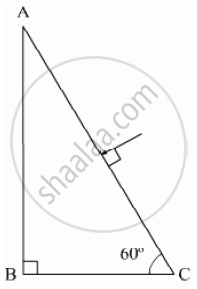Advertisements
Advertisements
प्रश्न
If light passes near a massive object, the gravitational interaction causes a bending of the ray. This can be thought of as happening due to a change in the effective refractive index of the medium given by n(r) = 1 + 2 GM/rc2 where r is the distance of the point of consideration from the centre of the mass of the massive body, G is the universal gravitational constant, M the mass of the body and c the speed of light in vacuum. Considering a spherical object find the deviation of the ray from the original path as it grazes the object.
उत्तर
Let us consider two spherical surfaces of radius r and r + dr. Let the light be incident at an angle θ at the surface at r and leave r + dr at an angle θ + dθ. Then from snell's law,
`n(r) sin θ = n(r + dr) sin(θ + dθ) = (n(r) + ((dn)/(dr)) dr) (sin θ * cos dθ + cos θ * sin dθ)`
⇒ `n(r) sin θ = (n(r) + ((dn)/(dr)) dr) (sin θ + cos θ * dθ)`
For small angle, sin dθ ≈ dθ and cos dθ ≈ 1
Ignoring the product of differentials
⇒ `n(r) sin θ = n(r) * sin θ + ((dn)/(dr)) dr * sin θ + n(r) * cos θ * dθ`
or We have, `- (dn)/(dr) tan θ = n(r) (dθ)/(dr)`
`(2 GM)/(r^2c^2) tan θ = (1 + (2 GM)/(rc^2)) (dθ)/(dr) ≈ (dθ)/(dr)`
`int_0^(θ_0) dθ = (2 GM)/c^2 int_(-oo)^(oo) (tan θ dr)/r^2`
Now, `r^2 = x^2 + R^2` and tan θ = `R/x`
`2rdr = 2xdx`
Now substitution for integrals, we have
`int_0^(θ_0) dθ = (2 GM)/c^2 int_(-oo)^(oo) R/x (xdx)/(x^2 + R^2)^(3/2)`
Put `x = R tan phi`
`dx = R sec^2 phi d phi`
∴ θ0 = `(2 GMR)/c^2 int_((- pi)/2)^(pi/2) (R sec^2 phi d phi)/(R^3 sec^3 phi)`
θ0 = `(2 GM)/(Rc^2) int_((- pi)/2)^(pi/2) cos phi d phi = (4 GM)/(Rc^2)`
⇒ θ0 = `(4 GM)/(Rc^2)`. This is the required proof.
APPEARS IN
संबंधित प्रश्न
Derive Snell’s law on the basis of Huygen’s wave theory when the light is travelling from a denser to a rarer medium.
Calculate the speed of light in a medium whose critical angle is 45°. Does critical angle for a given pair of media depend on the wavelength of incident light ? Give reason.
Trace the path of a ray of light passing through a glass prism (ABC) as shown in the figure. If the refractive index of glass is `sqrt3`, find out the value of the angle of emergence from the prism.

Find a critical angle for glass and water pair, given the refractive index of glass, is 1 ·62 and that of water is 1 ·33.
Derive Snell’s law of refraction using Huygens’s wave theory.
Define the term, “refractive index” of a medium. Verify Snell’s law of refraction when a plane wavefront is propagating from a denser to a rarer medium. Solution
Using Huygen’s wave theory of light, prove Snell’s law of refraction of light.
Draw the shape of refracted wavefront when the plane incident wave undergoes refraction from optically denser medium to rarer medium. Hence prove Snell’s law of refraction.
The mixture a pure liquid and a solution in a long vertical column (i.e, horizontal dimensions << vertical dimensions) produces diffusion of solute particles and hence a refractive index gradient along the vertical dimension. A ray of light entering the column at right angles to the vertical is deviated from its original path. Find the deviation in travelling a horizontal distance d << h, the height of the column.
A ray of light is incident on a glass prism of refractive index µ and refracting angle A. If it just suffers total internal reflection at the other face, obtain a relation between the angle of incidence, angle of prism and critical angle.
